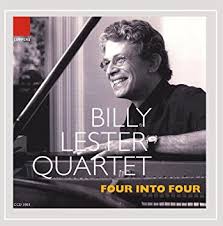This uptempo burner is based on the changes of I'll Remember April, with some reharmonization that also appears in the solo changes. The head is propelled by snappy rhythm section figures, including some stop-time at the beginning and end of the A section. The melody has a lot of rhythmic, repeated sequences that move around by seconds or thirds. The C section is the same as the A section, unlike some other Billy Lester songs whose melodies have no repeats, though the underlying changes may repeat. In many places, especially the bridge, the melody is based on upper extensions of the chords such as sharp or flat ninths and sharp elevenths.
The main reharmonization of the original changes is in the seventh to ninth measures, with both Gm7 and the tenth measure's D7 approached a half step above, the former as a II-V7 (A♭m7-D♭7-Gm7-C7). This is used in the solos as well as the head. Another reharmonization is in the 12th to 14th measures of the head, which have a sequence of three-beat stop-time figures with chords descending in thirds; the solo choruses use the original changes here. The 13th measure of the bridge has C6; Cmaj7 is played here in the solos. Alternate solo changes are indicated below the staff in a couple of places.
The bass doubles some of the piano left hand figures. Our bass part shows the rhythms of the melody below the staff.
For a fascinating insight into different ways to interpret standard changes, compare this song with
Gigi Gryce's Salute To Birdland and
Bobby Jaspar's Flute Bob, also based on
I'll Remember April.
Grasshopper's Holiday has more in common with Lennie Tristano's
April, yet another
I'll Remember April contrafact, in its inventively convoluted lines and excursions slightly outside the original changes.
In addition to our lead sheets, we have a piano part available showing how Billy plays the head on the recording. He doubles the melody with the trumpet throughout, voicing some of the longer notes but playing most of it as a single line in the right hand. Several left-hand figures fill in around the melody, including an eighth-note figure in the fourth measure that forms a dialogue with the melody line in the following measure.


